

HOW CAN I IMPROVE STUDENT LEARNING THROUGH THE IMPLEMENTATION OF SEVERAL STRATEGIES RELATED TO REFLECTIVE PRACTIC?
Jennifer Sztramko
Abstract
The Career Studies course is a half semester – half credit course presently being offered at the Grade 10 level at my school that students in the OSS curriculum must pass in order to graduate. The high failure rate of students in this course was becoming of great concern to both teachers and administrators. This Action Research project investigated ways to improve success rates in this course through a variety of reflective work that was designed to assist the student and the teacher, as well as maintain the integrity of the course.
This article will demonstrate that through the use of reflective writing, collages, standardized file-folders and front-end loading course assignments in the Career Studies course, the following findings were noted:
- the teacher became familiar with the students’ lives and interests in a personal way through their own language (pictures and words)
- the course failure rate dropped
- the rate of completion of portfolios increased significantly
- the confusion previously related to the requirements of the students’ personal profile assignment was lowered
- the teacher workload was significantly reduced at normally heavy marking times of the semester
Background
Initially, my research was going to improve student learning through the use of reflective writing in portfolios. I was concerned about the failure rate in the Career Studies course offered at the Grade 10 level. The overall failure rate of 21% for the first year that this course was offered was of concern for me because of the need for the students to pass in order to receive their Ontario Secondary School Diploma (OSSD). The main reason for such low marks was lack of completion of both course assignment work worth 70% of their term, and portfolio work – a part of the culminating activity worth 15%. The portfolio was the collection of specific class work assigned throughout the course.
I felt that I had given the students every opportunity to achieve success by:
- allowing students the full course time to hand in completed work – assignments with deadlines at the beginning of the course could be handed in on the last day for full evaluation;
- not penalizing any late assignments, according to the OSS documents for assessment and evaluation;
- giving students frequent reminders of deadlines for assigned work;
- having regular homework checks of assignments and requiring students to stay after class in order to complete work.
The Career Studies course runs in tandem with the Civics course – another half semester – half credit course. The Civics/Career Studies courses are time-tabled in the same time slot, back-to-back so that each runs for 9 weeks (45 days) of a semester. At the mid-point of the semester students are switched into the complementary course. All students in the Ontario secondary school curriculum must pass Career Studies and Civics in order to graduate.
June 2001: Personal Reflections
As I was marking the final portfolio work of one student, Mark, in June 2001, I noted an example that was of the quality I expected. I had seen this happening with some of the students throughout the semesters of the first year, but had given the work back. Mark did not come to pick up his portfolio at the end of June, and so I had it as an example for this research. Mark had organized his work by units, and he had completed most of the required work. His reflective pieces showed a level of thought that I wanted from all of my students. I noticed that through the portfolio/reflective assignment I only got to know the students at the end of the course and by then they were gone to another course. I also realized that up to this point, the reflections that had been requested by the text had limited scope. This is where I began thinking of how to improve reflective practice in order to improve student success in the Career Studies course.
Note: The portfolio was a collection of work completed by students throughout the course which was to show a progression of their thinking. It also included work assigned from the “Be Real Game”. Work for this activity was assigned in such a way that students could not complete one part without having completed the preceding parts. In this way, by having the students include one piece of the “Be Real” assigned work, I knew that they had completed the part before.
Here are some excerpts from Mark’s portfolio.
Mark’s Portfolio Entries
To the question, “Do you want someone else running your life for you?” he answered, “No, because the future they choose for me may not be what I enjoy doing.”
To the question, “How comfortable are you at this time of your life with the idea of taking charge of your own life?” Mark answered, “I am a little uncomfortable but in order to make the future I desire then I must take charge.”
In one self-understanding exercise, students were to picture themselves 15 years in the future. This was to be done at the beginning of the course and then approximately 1 to 2 weeks later. When recording the differences in his answers from one week to the next, Mark stated, “The last time I did this particular [ exercise ] was only about a week into the course, so nothing as really made an impact on me to change my answer. However, this time around I seem to be more dedicated to both my family and work, when I decided that they were most important. . . . the biggest change this time around, was that I now see myself getting married, and getting a dog.”
Students were to reflect on the learning that had taken place in Unit 1. Mark gave a rather lengthy reflection which provided great insight into his development. “. . . The first unit focused on pinpointing the attributes that make me who I am, and discovering the choices that have impacted my life. It has become apparent to me that my interests, dislikes, and hopes for the future have changed from an adolescent to a teenager. Understanding what influences my choices and interests helps me to discover what I want or dream about most in life. . . . Basically from that first unit I learned that no matter what the decision, you must make it yourself and accept it to be truly happy, otherwise, you may regret it for the rest of your life wondering about how it could have been different. . . . I have learned that no matter how minor the decision, it has an impact on your life in some way or another, and that you should stand up for what you believe in. . . . The goal aspect of the unit taught me how to focus and create goals that were measurable. Our assignment was to repair goals that were not measurable. From that experience I have learned that you can set all the goals in the world, but you have to really want to achieve them or they won’t get done. . .”
After reading Mark’s entries I then began a thought process that revolved around getting the students to produce quality reflective writing. My question then focused on how to provide students with opportunities to practice reflective writing within the time constraints of the course.
Without reflection, a portfolio has little meaning. (Rolheiser et al., 2000, p. 31)
Where did I want to go with this?
As I was researching reflective practices from September to November, 2001, I came to realize that it was not reflective practice with portfolios that I wanted to do. There were other issues that had to be dealt with before we could get to writing true reflective pieces.
Four issues were identified as needing to be addressed in order for students to have success with the Career Studies course:
Issue #1 – building a relationship/rapport with students in a fast and simple way.
Issue #2 – using file folders that were distinct and quickly identifiable for students in which to place their portfolio contents.
Issue #3 – assigning a project early in the program that would best illustrate students’ immediate interests and life, thus lessening confusion associated with a later project that requires students to reflect upon the results of interest, personality, and learning styles tests. This misunderstanding had resulted in poor marks.
Issue #4 – front-end loading course assignments to reduce the marking that was concentrated at the end of the course (mid-term). (Morgan, 2000).
For each of the above issues, I will give a background and then how it was dealt with in September, 2001 and then in November, 2001.
Issue #1 – Building a Student/Teacher Relationship Through Reflective Writing
Throughout the previous year I had felt a growing dissatisfaction with my inability to get to know the students on a more personal level. Given the nature of the course, I felt it extremely important to know the students in order to help them explore their interests, skills, personalities, abilities and, to relate those to some of the fields of work and occupations available now and in the future. I felt that I would be better able to meet their needs if I had some idea of where their thinking was regarding their knowledge of themselves and what their interests and abilities were. Forty-five class days did not allow for this to happen in the traditional way that a full semester course afforded.
I found that the natural rhythm of a full semester course was not present. By the time I was getting to know the students, which usually happened, in my experience, by the sixth week of a semester, the course was practically over with only 3 weeks left. Students were rushing to complete the culminating activities, as well as any late assignments, and getting ready mentally and physically to move on to the Civics course.
September 2001
In Burke’s (2000) How To Assess Authentic Learning, the chapter on Metacognitive Reflection states that “Teachers need to introduce strategies that promote metacognition (explained below). One of the key pieces in the portrait of a student for the twenty-first century involves self-assessment. In teachers’ attempt to ‘cover the content,’ ‘teach the textbook,’ and ‘prepare students for the test,’ they often neglect the critical piece that allows everyone to step back and reflect on ‘what we did well, what we would do differently, and whether or not we need help” (p.128).
Essentially, reflection is linked to elements that are fundamental to meaningful learning and cognitive development:
- The development of metacognition – the capacity for students to improve their ability to think about their thinking.
- The ability to self-evaluate – the capacity for students to judge the quality of their work based on evidence and explicit criteria for the purpose of doing better work.
- The development of critical thinking, problem solving, and decision making –the capacity for students to engage in higher-level thinking skills.
- The enhancement of teacher understanding of the learner – the capacity for teachers to know and understand more about the students with whom they work (emphasis mine) (Rolheiser, Bower & Stevahn, 2000. p. 31-32).
This last point was the critical piece that I was looking for. I had found that by using the traditional reflective pieces associated with the portfolio, learning about the student tended to come at the end of the course and thus did not allow for understanding of the learner when it would have been most helpful. Therefore, in order to enhance the teacher understanding of the learner, a connection had to be made with the students sooner.
Traditional forms of Reflective Practice such as PMI (pluses, minuses, intriguing or interesting), KWL (what I know, what I want to find out, what I learned), modeling reflective practice for the students through diagrams such as clouds, Multiple Intelligences and reflective practice, (Burke, 1999, pp. 45-50, 131-133) and, Retelling, Relating, Reflecting (Schwartz & Bone, 1995, p. 38-45) did not have the right fit for what I wanted to accomplish. In order to enhance my understanding of the learner, and, in order for meaningful development and cognitive learning to occur, the method of reflective practice had to take into account the time factor. The activity had to be simple and fast.
November 2001
In November, 2001, I began the course by having the students write a one-page piece titled, “All About Me.” I asked them to tell me about themselves, their interests, how they spent their spare time, what their plans for the future were, what their dreams were, what they enjoyed doing. I requested that it be one page in order for them to tell me at length more details about their lives. The open-ended nature of this piece I felt would appeal to more of the Multiple Intelligences than would a work sheet with fill-in-the-blank or short answer questions. It would also adapt better to all the learning levels of the students taking this open course. This would be my first contact with them on a personal level. I felt that writing their thoughts would be better than verbally giving this information in class because they would feel safer. The students would be able to write honestly without fear of ridicule from their classmates. I also let them use their own lined paper rather than handing out a more formalized handout generated by me. This method gave me more information about each student. I wrote in my journal November 12 -13, 2001, “I think that by having them use their own paper, it enabled them to pick the format - essay, poem, paragraphing. Have you noticed the differences among the types of paper that are sold to students?”
After reading through the “All About Me” Reflective Pieces, I realized that I learned something about each of my students sooner than I would have normally. I was surprised at how personal some of their writing was. “In these reflective pieces they tell me things which they wouldn’t talk about in class” (Sztramko, November 28, 2001)
I have used italicized font to show my reflections on their reflective pieces as revealed in the action research project group meetings with Diane Morgan.
Jenny - “I do not live with either of my parents at this time due to disagreements and arguments. For five years I have been making very bad decisions causing only temporary living situations. . . . Despite all of my personal problems, I plan to learn from my mistakes and move on and accomplish many things in life. I have started to restore my relationships with the people who I have hurt, especially my family.” I was surprised by the openness and honesty of this piece. It helped me make what I did in class more relevant to her learning. She did not attend class very often, but I prepared for her presence (Morgan, 2000).
Sam - “If I could, I would sleep all day long. I enjoy going up north, because I can get away from the city. I like to work outside, with nature. I find it better than working in an office. . . . every Sunday, I go for a ride on my quad. Next year I plan on racing. . . When I am older, I plan on working in a trade. I am aware of the shortage of workers and ones that will be needed, so that is what I plan to do!” This gave me so much information into his character and explained why he had trouble staying in his seat. While he wrote about wanting to become a trades person, he didn’t say which one. This provided me with further opportunities to connect with him. It also gave me direction for the use of examples in class.
Candice - “I have no clue what I want to be doing. I’m interested in teaching young children I think, but I’m not sure if it’s really the actual teaching that I like, or just writing on chalkboards. I’m very confused of what I hope to become so I’ll need to put some thought into it.” Wow! How honest is that!
Ian - “I want to go to an apprenticeship program hopefully at _________ Electric. I wish to go there because one of my best friends work there and wants to teach me all that he knows. . . . I like to work on lawn mower and small engine repair. I am currently working on my dad’s ‘67 Cavelle which in the future I wish will be mine. . . . I now received a part time job in construction and in a restaurant for special occasions. ” This told me about his interests in becoming an electrician and he had taken the initiative to ask about possible apprenticeship positions.I found Ian to be very quiet in class and although he participated in classroom discussions, he was a person of few words. I found his writing to be a window into his desires and interests. This became a springboard for further private discussions with him throughout the rest of the program.
Fred - “My name is Fred. I live in a small apartment. We never have any food. I have a lot of posters. I like heavy music like KORN, Coal Chamber, ... I hate school and I can’t get a job. I drink and smoke to escape my problems because I am too pathetic to handle them any other way. I have a girlfriend who I have been seeing for 5 months and 2 weeks. I don’t have anything else to say.” This is the most I have seen him write at this point in the semester. He actually stayed in my class for the whole period. I thanked him for ‘hangin’ in’ (Sztramko, 2002, November 12 -13, 2001). He had previously attempted the Career Studies class twice and had not completed it in either attempt. Previously, Fred had not participated orally in class. I included this here because it truly demonstrates the differences between my previous practice and what I was now trying to research. I would never have gotten this information just from asking for oral reflections or a fill-in-the blank questionnaire.
“We do not learn from experience. We learn from the reflecting on experience” (John Dewey in Rolheiser et al, 2000, p. 31). Therefore any experience that we reflect on will be a learning experience. If the student has the chance to reflect on what they like, want to be, at the beginning of the course then they will have already learned something about themselves.
Issue # 2 – The Logistics of the Portfolio
September 2001
To make the portfolio a distinct holder, I had instituted a system where each student would buy from me a legal-sized coloured file folder. They would choose the colour and I would then go and buy the files, collect the money and hand out the files. The size of the file folders and the colour distinction gave me control of the holders, and enabled each student to have a place for any future materials associated with their career search. I also felt that if the files were distinct from their other courses, the students would make a greater commitment to the project. However, I became dissatisfied with this system because of the time and energy involved several times per semester. I did not feel that the students were committing to the project.
When I spoke with the Coordinator of Assessment and Career Education, about the Portfolio/Reflection research project, he questioned me about the container I used for the Portfolio. I explained to him the coloured file folder system that I had put into place and my dissatisfaction with how it was working. He then suggested that I use the Personal Development and Career Planning Portfolio folder given to schools by the school board. I accepted this suggestion because it simplified the logistics of the type of container for me. I had wanted something that was distinct so that the students would distinguish it from their other school supplies. (Sztramko, October 23, 2001)
November 2001
In November the Personal Development and Career Planning Portfolio folder were introduced into the course. This folder gave the portfolio an official status. They were distinct and uniform – all students got the same one. The students reacted with enthusiasm to the information requested by the folder and many began looking at it with interest. Some began filling in the spaces provided on the file folder. (Morgan, 2002)
Issue # 3 – The Personal Profile Extension Assignment
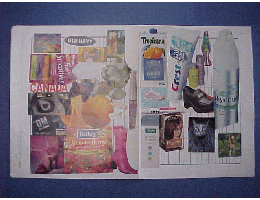 September 2001
September 2001
One assignment that the students seemed to misinterpret was the Personal Profile Extension Exercise assignment (Wallace, 2001, Activity #3, p. 53). This assignment required the students to use the information they had gathered in their personal profile chart and present it in another form such as: a collage, poem, mobile, video or another medium of their choice. I found, however, that instead of getting an extension of the information contained in their personal profile, students were completing the assignment as one representing their likes and dislikes. They were not recording their abilities, skills, intelligences, learning styles, personality types and other qualities. As a result, the students were earning a lowered mark because of not meeting the requirements of the assignment.
I felt that what was needed at the beginning of the course was an assignment that would allow the students to express their likes and dislikes as well as the other known aspects of themselves as they understood them at that moment. This would allow them to get it out of their system and be able to then focus on the requirements of the assignment. If students did this, then they would have greater success with the Personal Profile Extension Exercise assignment that came later.
November 2001
The new assignment called “All About Me”, consisted of two parts: a collage and written piece. The students were given the following definitions of a collage and reflection.
Collage – an organized, neatly arranged collection of pictures that illustrate who you are and what your interests are or have been. Each picture is to be securely fastened to the background folder or cardboard.
Reflection – on a separate lined paper write a description of each picture clearly explaining its significance in or to your life.
I chose the collage because most students when they did the Personal Profile Extension Assignment made a collage. I also had the magazines, markers, glue, crayons, and poster paper available. Students were to tell who they were pictorially/with pictures. They were not simply to include what they liked; they were to find pictures or draw those that represented who they were. Yes, they could include their interests but their reflective writing could not begin with “I like ________ because”. Students could choose the size of paper onto which the pictures were to be placed. It was to be titled “All About Me”. This then became an extension of their previous “All About Me” written piece but with a difference.
I modeled my expectations (McKenzie, 1999, Ch. 19) by using a sample picture of dying house plants. I said, “This is so me. I cannot keep house plants alive. In fact when people give me a potted plant I have anxiety attacks because I think, ‘Oh no! Now I have to keep this thing alive and I won’t be able to. I kill cactuses!’ I prefer cut flowers to live plants because they are already dead. I know that in few days the bouquet of flowers will wither and die. That’s why I raise kids and cats. They can tell me when they’re hungry.” (Sztramko, November 13 - 14, 2001) I use this as an example because it isn’t relating to something that I like or don’t like – it truly represents who I am. I express myself with lots of emotion in order for the students to understand my distress over the situation that arises when people give me house plants. In this I tell the students something about myself. They get to know about me. I also add other examples such as my cats and how much a part of my family they are. I do not say, “I like cats.” I state specifically that I do not want them writing about what they like or do not like because I tend to get pictures of alcohol and other leisure pursuits. This is not the purpose of this collage.
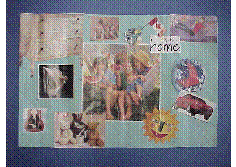
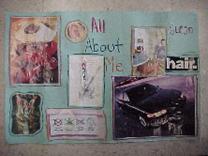
The students worked on these for two days. As they were working, I went around and stated, “Tell me about your pictures.” I then prompted with further questions.
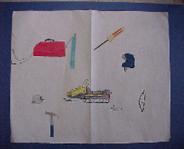 Ian – electrical symbols, snowmobile. “I’m not sure how to draw a 1987 snowmobile. I put in $400 of my own money. My parents paid another $600. I’ve spent 4 months rebuilding the motor. I had to fibreglass the hood. I had to repaint it. My dad showed me what to do.” If I hadn’t done this assignment I would never have known this about Ian. He is quiet and calm. Very strong in his opinions and thoughts (Sztramko, November 13 - 14, 2001 ).
Ian – electrical symbols, snowmobile. “I’m not sure how to draw a 1987 snowmobile. I put in $400 of my own money. My parents paid another $600. I’ve spent 4 months rebuilding the motor. I had to fibreglass the hood. I had to repaint it. My dad showed me what to do.” If I hadn’t done this assignment I would never have known this about Ian. He is quiet and calm. Very strong in his opinions and thoughts (Sztramko, November 13 - 14, 2001 ).
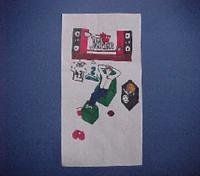 Greg – drew all his pictures. He likes drawing. A boy spread out on a chair and ottoman. Hands behind head. Jerseys hanging from knobs of a T.V. I ask him, “Tell me about your picture.” He assumed I knew about his involvement in sports. I didn’t. He has played football. He told me he had been removed from the football team because of classroom behaviour.
Greg – drew all his pictures. He likes drawing. A boy spread out on a chair and ottoman. Hands behind head. Jerseys hanging from knobs of a T.V. I ask him, “Tell me about your picture.” He assumed I knew about his involvement in sports. I didn’t. He has played football. He told me he had been removed from the football team because of classroom behaviour.
“Because of getting into trouble.” I said, “So this is like a punishment?”
“Yes”
When I asked if he was angry, he said, “Well it’s sort of embarrassing.”
Hmmminteresting. I was surprised by the honesty of his answer. He also said that he had played lacrosse “but not for a few years now” (Sztramko, November 13 - 14, 2001).
Angela – all of hers were also drawn. “I like drawing/art. I want to do something with art.” She then went on to tell me about her art class. “We’re using canvas in art now. Mrs. D. is letting us use canvas.” She said this in a very pleased/excited manner. I asked, “You like doing this? You’re happy about this?” “Oh, yes!” She had an animated smile on her face (Sztramko, November 13 - 14, 2001).
February, 2002
The course began again but the day before classes were to start, there was an ice storm. This left no time to prepare classes for start - up and there were marks and other end of semester items that need to be completed. As a result, I did not have time to read the first day journals “All About Me” that I would normally have done. Therefore, when the students were doing their collages, I used that opportunity to go around the class room to use their collages as a spring board for questioning the students. I found that I looked more carefully at their collages and my questioning was more targeted (Morgan, 2002).
I also let students complete their collages by pasting their pictures onto the inside of their portfolio file folders. I felt that this would be an efficient way to use available resources. I realized however, that this limited the students who preferred to draw. The background of the lines and columns on the file folder impeded those who were artistic (Multiple Intelligences). This conclusion was a major revelation that came out of the conferencing with Diane Morgan. Something that I had thought to be efficient was not in the best interests of the student learning (Morgan, 2002).
Issue # 4 – Marking Pressures at the end of the course
September, 2001
The course had been laid out to follow the order of the text book. Thus the majority of the marking came at the end of the course which, at midterm, resulted in a large amount of marking coming in all at the same time when there is no time allotted for this extra workload. I had to manage the activities and workload usually associated with the end of a semester at mid-term, when there was no time allocated to complete any of it. Furthermore, there were the additional start-up responsibilities and activities associated with the beginning of a semester, now at the mid point of the semester with no turn around time in which to prepare. While one day I was saying good bye to several classes, the very next day I was introducing myself to a whole new group of students and having to establish the parameters expected in the Career Studies course.
I had not fully understood all of this when first establishing the order of assignments. I did not realize the time required to mark portfolios and other assigned work and the lack of time available – especially at midterm.
I began assigning some work earlier in the course.
November, 2001
I focused on completing the work for the portfolio instead of covering the course. The portfolio was an accumulation of all work assigned in class. Therefore, if the assigned work was completed then the course was being covered.
I decided to begin front-end loading many of the major assignments such as the résumé, the cover letter, the information interview, and others. These could all be taught in isolation without being dependent on previous learning. I was pleased with the results. I decided to look for other ways to redistribute the work load not just for myself but for the students as well – midterm is a busy time for them too.
In February, another teacher was assigned two Career Studies sections because of teacher reassignment. I advised him to begin assigning projects early so as to get a start on marking. At midterm time when interviewing him about this he stated, “The course goes by too quickly. If you don’t budget your time, you’re in trouble. Other teachers don’t realize the pressures that are on teachers who teach the half semester course. At midterm when others are creating a mark for the students, we are having to come up with a final mark that counts.”
When I asked him what are key things to have in place in order to improve student successes he stated, “Begin with concrete skills – résumés right off the bat. Then cover letters and Can-Do Documents. Then, once they do that, we can talk about more abstract things” (Iwanyzki, April 10, 2002).
Conclusions
The failure rate in the previous year (September 2000 to June 2001) was over 20%. In the September 2001 group – those that started in September and completed the course in November 2001 – the failure rate dropped to 10%. In the November group – those starting in November and finishing in February – the failure rate was 0%.
In the two groups sampled, the quality of portfolios, and the rate of completion of the portfolios also improved. The portfolio completion percentage for the previous year (September 2000 to June 2001) had been 65%. Completion rate of portfolios (those attaining 50% or better) in the September 2001 group was 71%. In the November group it was 84%! This was a significant improvement.
When I saw these results I was very pleased and yet could not believe that these improvements were the result of such simple strategies. I attributed the above improvements to other things such as the number of repeaters in the second year of the course, the rumor mill of previous students telling other students the consequences of not completing their work, and the realization that failing the Career Studies course resulted in not obtaining their graduation diploma.
However, when I spoke to a recently retired Guidance Department Head on May 3, 2002, I told him about the demands of the Career Studies course and the quick turn around time. He was surprised and immediately said, “My goodness, how would you get to know all those students in such a short time?” This was the first thing out of his mouth. As he was saying this, I realized that what I had been doing was significant. Here was someone who understood the need for developing a rapport with students, its importance to the dynamic in the classroom and its impact on the success of the students. This was a major revelation to me. He validated my research (Sztramko, May 3, 2002).
References
Burke, K. (1999). The Mindful School: How To Assess Authentic Learning, Third Edition. Arlington Heights, Illinois.
Davies, A., et al. (1992). Together Is Better: Collaborative Assessment Evaluation & Reporting. Winnipeg, Canada: Peguis Publishers Ltd.
Iwanyzki, S. (April 10, 2002). Personal Interview Regarding Course Structure.
Morgan, D. (February 26, 2002). Conferencing Notes. Simcoe.
McKenzie, J.(1999) “Scaffolding for Success”; From Now On: The Educational Technology Journal. 9,(4).(fno.org)
Rolheiser, C., Bower, B., & Stevahn, L. (2000). The Portfolio Organizer. Alexandria, Virginia USA: Association for Supervision and Curriculum Development.
Schwartz, S. & Bone, M. (1995). Retelling, Relating, Reflecting: Beyond The 3 R’s. Toronto, Ontario: Irwin Publishing.
Sutton, R. (1997). The Learning School. Salford, England UK: RS Publications.
Sztramko, J. (2002). Personal Journal. September 2001 to April 2002.
Wallace, L. (2001). Career Studies 10. Canada: Nelson Thomson Learning, 2001.
Biographical Note:
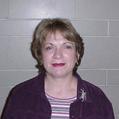 Jennifer Sztramko has been an enthusiastic teacher at Simcoe Composite School in Simcoe for the past 15 years. She is a Guidance counsellor and a teacher in the Humanities and Social Sciences Department. Previously she taught for the former Oxford County Board and held a headship position in Family Studies. She received her B.A.Sc. from the University of Guelph and her B.Ed from University of Western Ontario. Jennifer’s interests include: travelling, gardening, and music.
Jennifer Sztramko has been an enthusiastic teacher at Simcoe Composite School in Simcoe for the past 15 years. She is a Guidance counsellor and a teacher in the Humanities and Social Sciences Department. Previously she taught for the former Oxford County Board and held a headship position in Family Studies. She received her B.A.Sc. from the University of Guelph and her B.Ed from University of Western Ontario. Jennifer’s interests include: travelling, gardening, and music.
